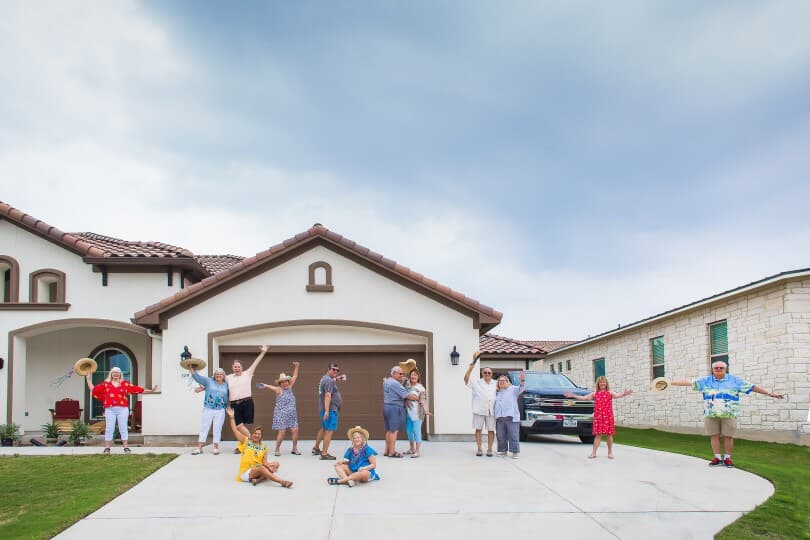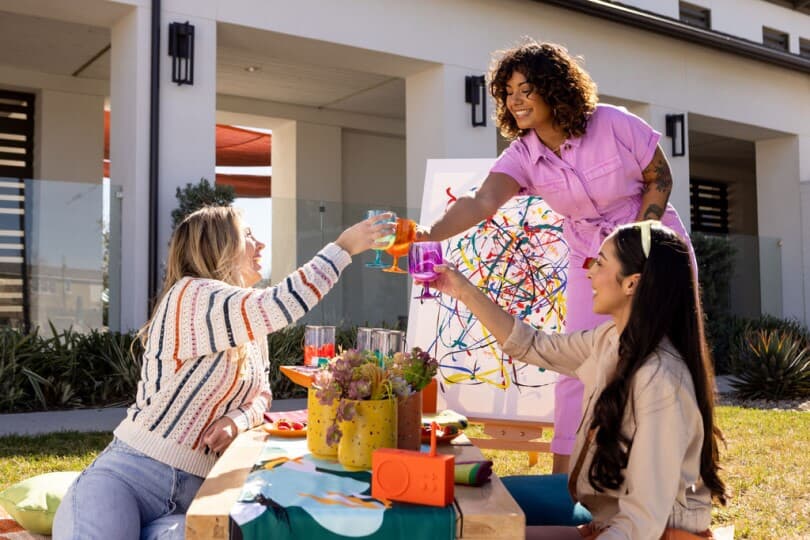10 Tips for Getting to Know Your Neighbors

One of the more fun tasks to tackle is getting to know your neighbors. They can be a valuable resource for community insights and making your new neighborhood feel like home sooner.
If you’re more of a homebody than a social butterfly, it can feel scary to put yourself out there. After all, you don’t want to say the wrong thing or make a bad first impression. But being a good, friendly neighbor doesn’t have to be an overwhelming ordeal.
We’ve put together ten easy tips for getting to know your neighbors in your new community:

1. Smile and wave to any neighbor you see
It seems like an obvious thing to do, but a smile and wave lets people know you’re friendly and receptive to getting to know them. As they say, there’s no second chance to make a first impression, so a simple greeting can go a long way. Eventually, this can turn into some small talk, which can lead to more meaningful conversations down the road. Start small and naturally work your way up.
2. Take a walk
Walking is not just good exercise, but it’s also a great way to get out and explore your new neighborhood. Try various routes, and say hello to any neighbors you see. Make an effort to engage in conversation (if they seem receptive) by asking about the project they may be working on in their garage or the dog they’re throwing a ball with. Make sure to share your name and let your neighbor know where you live.
Your dog is a great excuse to get out and explore. Chances are, some of your neighbors will also be out walking their dogs. Dog-to-dog interactions make an easy gateway for conversation, so seize the opportunity to chat with your newly acquainted neighbor.
3. Spend time outside
Instead of venturing out, let people come to you. You can relax on the porch, work in the garden, or play out front with the kids or dog. When someone comes along, wave and say hello. It’s a good opportunity to show your new neighbors you’re not too busy unpacking and getting settled, so you have time to engage in conversation.
If your community has amenities like a playground, pool, or dog park, spend some time there so you have more chances to meet people. It’s a neutral, casual setting that may provide an easy conversation starting point. Having kids of a similar age or equally rambunctious pups provides common ground allowing small talk flow.
4. Make the first effort
If you’ve seen some neighbors around and exchanged a smile and wave, take the initiative to go to their house and introduce yourself. It doesn’t have to be more than a simple “Hi, I just moved in, and I wanted to introduce myself,” but a small gift is a nice touch. Sharing baked goods or fruit from your trees is a great excuse to knock on some doors. Just be mindful when it comes to timing. Don’t show up at dinnertime or early on a Saturday morning.

5. Embrace the small talk
When meeting new people, it’s important to keep the conversation light and upbeat. Compliment them on their home or garden to lay the foundation of a friendly relationship. Be ready to share information about where you’re moving from, how the move went, or your household. People are naturally curious about who is joining their neighborhood, so be prepared to open up.
6. Ask questions
Nobody enjoys a one-sided conversation, so ask your neighbor questions to keep them engaged. Asking how long they’ve lived in the neighborhood is an easy one without being too intrusive. You can also ask for their insights on the best nearby restaurants, when the local farmer’s market sets up, or if they know a good landscaper.
7. Join neighborhood social media groups
Social media can be a great tool for connecting with your local community. If there’s an HOA, see if there’s a neighborhood group you can join to know the happenings where you live. Many cities have their own social media group where you can share local news and community events. There may even be subgroups dedicated to a specific sport or hobby so you can connect with people that have similar interests.
8. Host a housewarming party and invite the neighbors
If you moved somewhere with friends and family nearby, they’ll likely want to see your new place. Host a small gathering, and include your neighbors so you can get to know them better. You can invite people in person if you’ve talked to them or have exchanged phone numbers, or you can slip an invitation under their door or into their mailbox. Don’t feel like you need to include everyone. You can invite your direct neighbors or people you’ve talked to as a starting point.
9. Say “yes” when invited
When the opportunity presents itself, get involved. Whether it’s the monthly HOA meeting, a neighborhood block party, or the gathering next door, say “yes” if you’re invited (and able to attend). If people see you’re excited to join in and participate in the neighborhood, they’ll be more receptive to any getting-to-know-each-other efforts. If you’re constantly saying “no” when an invitation is extended, chances are the invitations will stop coming.
10. Be a good neighbor
While being friendly and social is great, it’s also important to respect people’s privacy and personal boundaries. Waving when you see a neighbor, following all the HOA guidelines, and being mindful of your noise are all good ways to be considerate of those around you. If you get the impression that your neighbor is uncomfortable around dogs, leave your pup at home when you say hi.
Don’t worry if not everyone wants to get to know you. Some people aren’t as extroverted or open to socializing, and it’s important to respect that. Even if you get the impression that some of your neighbors would prefer to keep to themselves, being friendly is essential to maintaining a positive environment in your neighborhood.
Get Connected in Your Brookfield Residential Neighborhood
At Brookfield Residential, our success is grounded in one thing – giving people the best places to call home. While we know we create great communities, we also know that the best part of them is the people who live there. That’s why many of our neighborhoods and communities include vibrant amenities and social opportunities where neighbors can connect. Explore where we build and connect with our sales team to learn more about the community amenities designed to turn good neighbors into great friends.
You can also check out the Brookfield Residential blog for design advice, homebuying insights, mortgage tips, and more, including The Benefits of Buying New Construction and The Advantages of Living in a Master-Planned Community.


